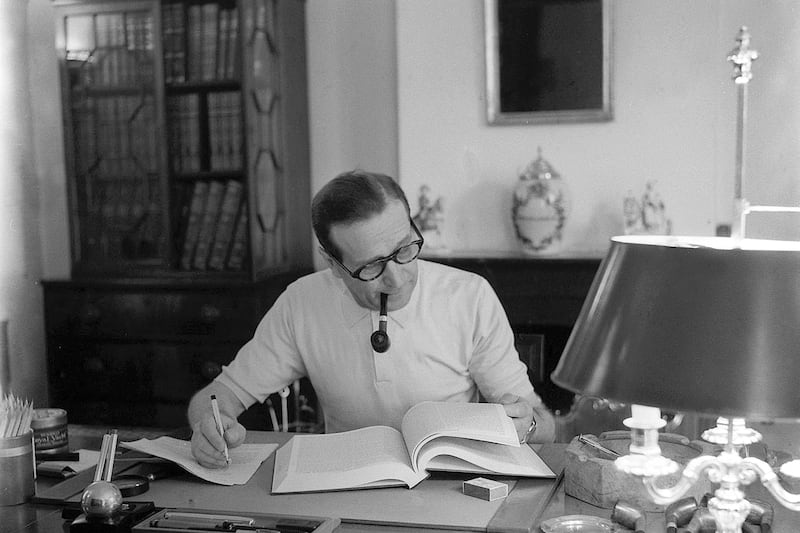At the beginning of What Remains by Brais Lamela (Bullaun Press, 144 pp, €14.95), translated from Galician by Jacob Rogers, the author reflects on the community he writes about, stating: “As long as they lived on their native soil, they would have to accept their own invisibility.”
These people, from the northwest corner of Spain, were forced from their land in the 1950s to make way for a hydroelectric dam. In the first half of the novel the narrator is in 21st century New York researching for a thesis “revealing the inconspicuous flow of information between American capitalist institutions to Franco’s dictatorship”. But the narrator is beset by doubts about his work, both the thesis and the autofictional novel we are reading, the veracity of which is sometimes questioned by his girlfriend, Mariana, who is also from Spain.
In the second half of the book, they travel with the narrator’s brother and ailing father to the area of Spain from which the peasants were removed. Squatters now occupy the remaining houses, some of which still contain items left by the former residents, allowing insights to be gained both from the new occupants and from the detritus of the past. The novel is always serious in its intent, even if it is more concerned with asking questions than finding answers, and while its style can seem quite random – tossing together anecdotes, speculation and conversations – these elements coalesce to allow us to understand the deep-seated attachment to memories and myths that make a people.
This is true too of the Jewish people, whose biblical origin stories continue to be invoked as the basis for fiercely disputed actions in the present day. That always contentious history is pivotal to The Effingers: A Berlin Saga by Gabriele Tergit (Pushkin Press, 824pp, £20), translated from the German by Sophie Duvernoy, initially a flickering apprehension in the peripheral vision of characters before impinging fully on their lives.
First published in 1951, the novel covers 1878-1948, a fascinating, if increasingly horrific, period for the families whose lives we see in great detail as they engage in the quickly expanding worlds of finance and manufacture. Their wealth leads to indulgent extravagance in one generation, which is then questioned by the next, although, except for one notable example, in swiftly forgotten ways, allowing for a conscience-free embrace of capitalism.
Most of what we learn is conveyed through dialogue, with little in the way of exposition or reflection. This results in a lack of depth or insight, and the reader’s engagement is required as the list of characters expands (a list of characters would have been useful), with many of the conversations deviating from the central concerns of the narrative.
But the polyphony of voices – sometimes deliberately discordant – allows a vivid sense of the city as it moves from the authoritarian rule of Bismarck to the freedom and decadence of the Weimar period, towards the advance of fascism. For the characters we come to know intimately, the rise to power of the Nazis is startling, then devastating.
It is typical of the novel that all of this is achieved without melodrama, ending in a scene of eerie quiescence. This far-ranging novel also reverberates with painful relevance for our time, as when a character says that, “across the world, optimistic, liberal ideas are dying ... The peaceful coexistence of people who are not all alike is considered intolerable”.
Unfortunately, that inability to live in concord is no easier on the micro level, as Eye of the Monkey by Krisztina Tóth (Seven Stories Press, 304pp, £14), translated from the Hungarian by Ottilie Mulzet, demonstrates with disenchanting immediacy. The key figure in the novel is a male psychiatrist, Dr Kreutzer, whom troubled people expect to be a source of solace. We quickly discover that he is a deeply manipulative individual who primarily works with female clients to exploit their vulnerabilities for his own gratification.
The novel employs a non-linear but realist style, alternating between first- and third-person perspectives. The personal narration is from Gizi, one of Kreutzer’s clients who, when we first meet her, is being followed by a man who believes her to have been his birth mother. Because she has never given birth, this becomes one strand of an intriguing novel in which the characters’ actions are often as surprising as they are disillusioning.
The writing style is cool, almost detached, but it is this precision that allows us to understand or repudiate the actions of the characters. More questionable, however, is the decision to locate the action of the novel in a dystopian future. This has little impact, and the portrayal of divided cities, where the wealthy and the impoverished reside separately, is cliched.
In Every Time We Say Goodbye by Ivana Sajko (V&Q Books, 124pp, €15), translated from Croatian by Mima Simić, the instability of present-day Europe is the backdrop for a novel in which violence is passed on through the generations like a defective gene. The first-person narrator, “a journalist and socially engaged author”, is on a train, escaping from a failed relationship, trying to find where the strands of brutality began and whether they will ever cease to embed themselves in society.
Having too often encountered violence enacted by his grandfather and father and, as a journalist, during civil wars in Croatia and Syria, he is overly acquainted with the cruelty of the world. His mother’s mother had “no love for girl children [because] it would spoil them and make them into women who expect love instead of punches”. The narrator’s dilemma is whether he will, as has been predicted, perpetuate the destructive anger.
However grim the subject matter, the writing remains exceptionally good, with long, majestic sentences that curl unpredictably around the subject. This profound novel is superbly translated by Simić, whose translator’s note is in itself fascinating.
There isn’t any violence in The Cat by Georges Simenon (Penguin Classics, 154pp, £10.99), translated from French by Ros Schwartz, but there is a bewildering level of cruelty. An elderly couple, Émile and Marguerite, live a stilted life of shared silence in the sole remaining house in a cul-de-sac. The man throws a pellet of paper towards the woman, on which is written “The cat”. In response, her piece of paper has “The parrot” written on it.
At first, this absurdity could be the work of Beckett, albeit without his taut sentences. Instead, this grimly fascinating novel is written in a clear, efficient fashion, the better to tell us what led to this peculiar domestic arrangement. The narrative – always told from Émile’s point of view – brings us to earlier times when they first met and were happy to communicate. The prolonged silence that followed the death of Émile’s cat, which he blamed on his wife, marked the beginning of a significant change in their relationship.
What perpetuates this codependence and the tedious repetitions of their daily affliction? It is a tribute of sorts to the capriciousness of humans that people can become accustomed to, or even dependent on, the most bizarre approaches to life. This novel, first published in 1967, illustrates our idiosyncrasies unsparingly.
The cruelty and stupidity of humans is evident throughout Beasts of the Sea by Iida Turpeinen (MacLehose Press, 286pp, £16.99), translated from Finnish by David Hackston. Beginning at the Bering Sea in 1741, the novel establishes the factors that led Georg Wilhelm Steller to discover the extraordinary sea cow, which would later be named after him.
Mixing scientific fact with fictional elements, the author details how it came about that, within 28 years of that first sighting, the sea cow was extinct. It was only in the late 18th century that Georges Cuvier presented a scientific paper proposing the notion of extinction. Even then, many who knew of the animal refused to believe that the sea cow might no longer exist.
The narrative continues through centuries in which animals were thought to exist solely for humans. This novel powerfully conveys a convincing message about the destructiveness of humankind toward other animals. The writing style is straightforward, although occasionally overly didactic. But its central truth should not be ignored.















